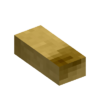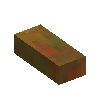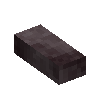Bronze: Difference between revisions
(Marked this version for translation) |
(pt tag) |
||
| Line 1: | Line 1: | ||
<languages /> | {{PT}}<languages /> | ||
<translate> | <translate> | ||
<!--T:1--> | <!--T:1--> | ||
| Line 41: | Line 41: | ||
<!--T:4--> | <!--T:4--> | ||
''' | '''Bronze''' is a Tier 3 metal alloy. Bronze is needed to progress past the Copper Age into the Iron Age. Bronze alloys must be created via [[Crucible|smelting]], and may be [[Casting|cast]] or [[Smithing|smithed]] into useful tools and equipment. | ||
</translate> | </translate> | ||
__TOC__ | __TOC__ | ||
Revision as of 15:28, 8 July 2022
| Tin bronze | |

| |
| Stackable | 16 |
| Smeltable | |
| Smelt Point | 950°C |
| Requires Container | Yes |
| Items | |
| Bismuth bronze ingot | |

| |
| Stackable | 16 |
| Smeltable | |
| Smelt Point | 850°C |
| Requires Container | Yes |
| Items | |
| Black bronze ingot | |

| |
| Stackable | 16 |
| Smeltable | |
| Smelt Point | 1020°C |
| Requires Container | Yes |
| Items | |
Bronze is a Tier 3 metal alloy. Bronze is needed to progress past the Copper Age into the Iron Age. Bronze alloys must be created via smelting, and may be cast or smithed into useful tools and equipment.
Obtaining
As an alloy, bronze is not naturally occurring and must be created by the player. Bronze tools may be sometimes sold by different traders, depending on the type of tool. Different metal ore nuggets must be mixed inside a crucible in the right ratios to produce usable molten bronze, which can then be cast directly into tool molds or in an ingot mold to form ingots.
Bronze types
Copper is a primary component of all bronze alloys. It may be alloyed with zinc, tin, silver or gold to create different types of bronze. Tin bronze and black bronze require high-temperature fuel like charcoal or coal to create, while bismuth bronze can also be created by burning peat, due to its lower smelting temperature.
| Bronze type | Smelting temperature | Copper % | Other metal % | Other metal % |
|---|---|---|---|---|
| Tin bronze | 950 °C | Copper 88-92% | Tin 8-12% | - |
| Black bronze | 1020 °C | Copper 68-84% | Silver 8-16% | Gold 8-16% |
| Bismuth bronze | 850 °C | Copper 50-70% | Zinc 20-30% | Bismuth 10-20% |
Usage
Bronze, similarly to copper, can be cast directly into tool molds or smithed as ingots on an anvil. Bronze tools are generally more durable than their copper counterparts, with more hit points. They also deal more damage and mine through appropriate blocks more quickly than copper or stone tools.
Different types of bronze produce items with different stats. Broadly speaking, the best bronze items are made of black bronze, followed by tin bronze and bismuth bronze. Better bronze types do more damage, mine faster, and provide more damage protection when made into weapons, tools or armor.
Tin bronze has higher mining speed, attack power and damage reduction than bismuth bronze items. However, bismuth bronze items have higher durability than tin bronze items.
Progression
Bronze anvils can be used to create iron anvils. Therefore, in order to progress into the Iron Age, players must make a bronze anvil at minimum.
| Ores, metals and minerals | |
|---|---|
| Guides | Ore Deposits • Metals |
| Metals | Copper • Iron • Meteoric iron • Gold • Silver • Lead • Tin • Zinc • Bismuth • Titanium (Ilmenite) • Nickel |
| Alloys | Bronze (Tin bronze, bismuth bronze, black bronze) • Steel • Brass • Solder (Lead solder, Silver solder) • Molybdochalkos • Cupronickel • Electrum |
| Minerals | Alum • Borax • Cinnabar • Coal • Halite (Salt) • Lapis lazuli • Quartz • Saltpeter • Sulfur • Sylvite (Potash) |
| Tools | Pickaxe • Hammer • Prospecting Pick • Crucible • Forge • Ore blasting bomb • Quern • Anvil • Bloomery • Helve hammer • Pulverizer |
| Other | Gemstones |
| Related mechanics | Panning • Mining • Clay forming • Casting • Smithing • Steel making |